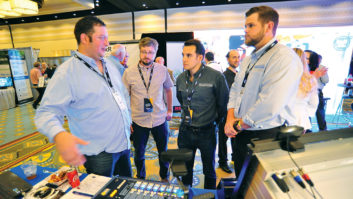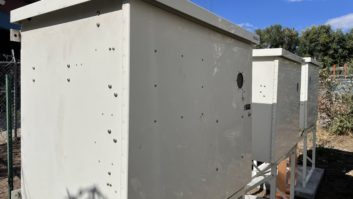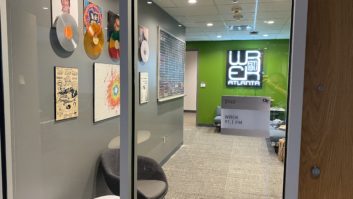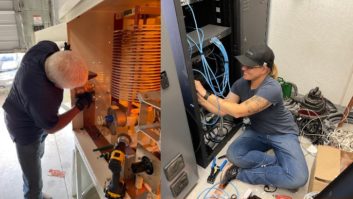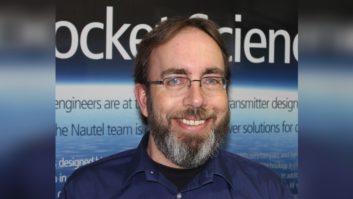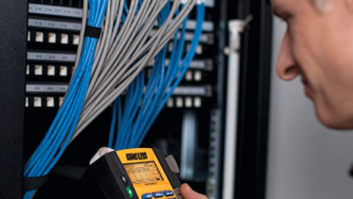Major New York and Los Angeles Projects Highlight NAB Facility Session
Tuesday morning, April 19: “Radio Broadcast Facilities”
Tuesday afternoon, April 19: “Broadcast Technical Regulatory Issues”
From 1,200 feet above Times Square to “beautiful downtown Burbank,” Tuesday morning’s session of the Broadcast Engineering Conference will showcase some of the biggest recent projects in the broadcasting world, as well as offering solutions for broadcasters with more modest budgets.
The “Radio Broadcast Facilities” session takes place 9 a.m. to noon. An afternoon session deals with technical regulatory issues.
If you build it …
The morning begins with a presentation from Jim Moser, senior staff engineer at Kintronic Laboratories, who will provide an overview of a new “Medium-Wave Feeder Design for Digital Broadcast.”
His paper presents a design methodology for improving the impedance and pattern bandwidth of MW directional antenna feed systems for digital broadcast, whether IBOC or DRM.
After that, it’s off to Hollywood – or rather, just over the hills in the San Fernando Valley, for the“Clear Channel Los Angeles Consolidation.” The big broadcaster recently completed a move of its entire Los Angeles radio operation – three AM stations, five FMs – into one facility.
The stations moved from four locations scattered across the sprawling Los Angeles market into a 100,000-square-foot space that overlooks NBC Studios. Each station occupies a “pod” of studio space that incorporates a production room, a studio for a morning-show producer, call screener or newscaster and a main air studio.
As Chief Engineer Terry Grieger will explain, each station is also now tied into a building-wide network that incorporates Harris consoles and audio networking and Prophet Systems automation.
And, being in the entertainment capital of the world, the facility has some “only-in-L.A.” touches, including a studio (one of 55 in the plant) right off the main lobby designed to accommodate live performances, of which the Clear Channel stations have plenty.
The morning will next turn to some seat-of-the-pants solutions for unusual facility issues. The session is “Remote Radio From Challenging Venues on a Budget.”
Radio Free Asia’s headquarters are in Washington, but Chief Technology Officer David Baden says the network’s typical remote in a country such as Cambodia or India presents challenges that most domestic broadcasters never have to consider.
“They don’t even have ISDN in some countries,” Baden said – or even, in many cases, a clean POTS line, when crafty locals hack their own home-brewed connections to what’s supposed to be a private line.
“You end up with party lines that weren’t supposed to be party lines,” he said.
As a result, Radio Free Asia has been experimenting with the use of VoIP connections and satellite-fed ISDN to get broadcasts on the air. In at least one case, as Baden and co-presenter Andrew Janitschek, RFA’s manager of production support, will discuss, the old “headphones-against-the-mouthpiece” trick turned out to be the best way to get one critical broadcast from the mountains of northern India on the air.
From India to the swamplands of north Jersey, the session turns to a project that’s become less and less common: construction of a new high-powered AM transmitter plant.
Tom Ray, corporate director of engineering for Buckley Broadcasting, is taking on that task at WOR(AM), New York, where an existing transmitter facility is soon to be razed for construction of a golf resort. His presentation is “Building a 50 kW AM Facility in the Jersey Meadowlands.”
Ray says building a new $9 million site, complete with three 670-foot towers, less than a mile away has been a lesson in bureaucracy.
“We’ve had to deal with everything from the Army Corps of Engineers to the Bergen County soil conservation permit,” he said. Those were easy compared to the big challenge, getting FAA clearance for new towers in close proximity to Newark Liberty International Airport and the private Teterboro Airport, where the FAA had to be persuaded to alter the standard rate of climb for a takeoff in order to clear the new towers.
“Plus the fact,” Ray noted, “that we’re literally building in a swamp, with bedrock at 165 feet down.”
The morning will conclude with a project that’s been going up within sight of Ray’s swamp, as session chair John Lyons of New York’s Durst Organization shows off his recently-completed work at Manhattan’s “4 Times Square Construction Project.”
“We want to show how four manufacturers could work together in a timely fashion to get this done in a tight urban area,” Lyons said of the project, which added a 385-foot mast and 6,000 square feet of transmitter space to the building to provide much-needed FM and TV transmission capacity in the wake of the 9/11 attacks.
Lyons will be joined by partners in the project, Phil Cindrich of Myat, Kerry Cozad of Dielectric Communications, Thomas Silliman of ERI and Bob Surette of Shively Labs to discuss the challenges they faced to get the job done in a short time frame during 2003.
“Shively had to do literally a whole redesign of the transmission path right in the middle of the project,” Lyons said. Delivery of equipment and supplies had to be tightly coordinated to avoid overflowing the limited workspace at the building, and to avoid leaving expensive union work crews idle.
Rules, rules, rules
In the wild new world of spread-spectrum broadband and other services that operate without licenses in the upper reaches of the radio spectrum, broadcasters face challenges they never could have imagined a decade ago.
Those challenges will be discussed Tuesday afternoon at the “Broadcast Technical Regulatory Issues” session.
Chairperson Dane Ericksen, senior engineer at Hammett & Edison, says the issue of interference protection and spectrum allocation is hitting broadcasters across the spectrum, including the 2 GHz band, where TV broadcasters face a massive (and massively expensive) relocation of the auxiliary service they use for live shots and other remote purposes, and the broadcast TV bands, where new wireless devices and the coming of digital TV create threats to existing users of the spectrum.
For radio broadcasters, though, the biggest issue is a change in the way the FCC handles the 950 MHz broadcast auxiliary service.
Since last year, the FCC has required broadcasters to coordinate their use of that spectrum through “Part 101” coordination, which has required broadcasters to use a frequency-coordination service such as Comsearch (whose vice president, Tim Hardy, will be speaking) to notify other nearby 950 MHz users every time they need to make changes to an STL path or other BAS use that could cause interference. Hardy’s presentation is “Auxiliary Broadcast Microwave Implementation: Six Steps to Success.”
Ericksen says it’s been a challenge to come up with a clear understanding of what constitutes interference in that service, since the FCC still uses a technical service bulletin that’s more than a decade old and not designed with broadcasters in mind.
“A group was formed at the SBE national meeting in Boston last October to come up with frequency coordination specifications for broadcast auxiliary services,” Ericksen said.
Much of the afternoon session will be of interest to those involved in TV. Topics include the 2 GHz BAS relocation; interference to UHF TV reception from wireless mics; potential UWB interference to DCII, ATSC and DVB-S C-Band reception; evaluating the impact of unlicensed operation in the TV broadcast bands; and implementation of DTV rules for LPTV and TV translators.





